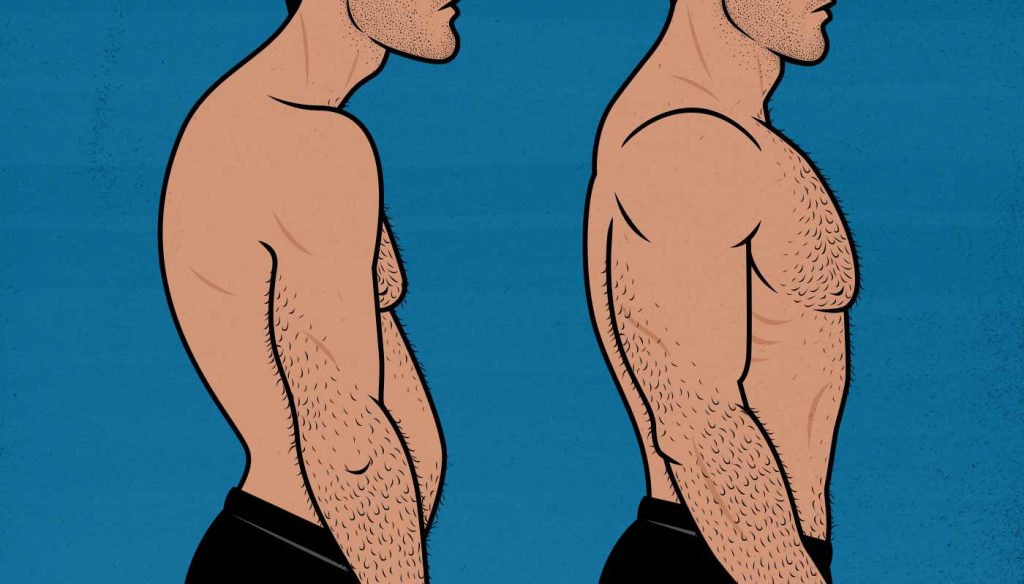
The Skinny Guy’s Guide to Fixing Bad Posture
It’s common for skinny guys to have crooked posture. Part of that is because we’re skinny. We lack the muscular strength to hold ourselves up straight. The other problem is we often have longer spines that are harder to stabilizer.
The good news is both of these issues are the same issue. You can think of posture as weakness in the muscles that are supposed to hold your body in the proper position. If you can learn how to lift weights with good posture, you’ll strengthen these muscles, and your posture will improve.
My expertise is in helping thinner athletes bulk up, including college, professional, and Olympic athletes. Fortunately, these postural techniques work just as well on everyday skinny guys like us.
How to Fix Slouching Posture
As we mentioned above, having a bony upper back that rounds over with kyphosis is incredibly common with naturally skinny guys. That’s because these issues go together. A weak upper back won’t be able to hold your body in the correct posture.
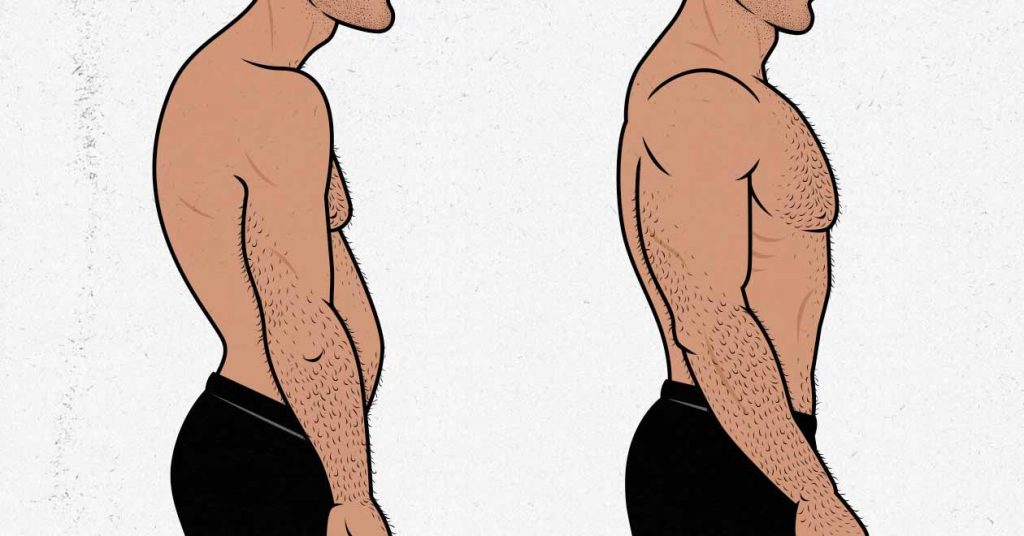
The best fix for bad posture is to get bigger and stronger. Now, that doesn’t mean just doing rows and pull-ups/pulldowns. Those exercises will greatly strengthen your lats, traps, and rear delts, but we also want to strengthen all of your spinal erectors and postural muscles. That will accomplish three things:
- You’ll build a wider, more muscular upper back.
- You’ll build a thicker upper back that makes your torso look bigger from the side.
- You’ll be bulking up the muscles that hold your back in a strong position.
There are a few great exercises for that.
The Best Exercises for Straightening Your Back
If you’ve read our article about how skinny guys should lift to gain muscle size, you know we build our bulking routines around the “Big 5” compound lifts:
What’s interesting about these lifts is that, except for the bench press, they’ll all help you build up a bigger and stronger upper back. Furthermore, if you’re a beginner, we usually recommend starting with the push-up instead of the bench press, which is great for your upper back. Now, it’s not that the push-up will bulk up your back muscles, but it will certainly strengthen your shoulder muscles and serratus muscles, which will build up the stabilizer muscles in your shoulder girdle.
The best compound exercises for bulking up your upper back are:
- The deadlift (or Romanian deadlift)
- The front squat (or goblet squat)
- The chin-up (or lowered chin-ups)
If you’re still a skinny beginner, choose a beginner program with beginner variations. Beginner exercises are easier to do with proper technique, making it much easier to build good posture.
- Romanian deadlifts
- Goblet squats
- Chin-ups (or lowered chin-ups)
- Dumbbells rows
- Lat pull-downs (or pullovers)
I wouldn’t do all these exercises in the same workout, but you certainly could. If it were me, I’d mix them into full-body workouts. So that might look something like this:
- Monday: Chin-ups and goblet squats + other lifts
- Wednesday: Romanian deadlifts and pullovers + other lifts
- Friday: Goblet squats and rows + other lifts
Some of these exercises might be obvious. Most people know that chin-ups and rows are good for building a bigger upper back. However, most people don’t realize just how incredible deadlifts and front-loaded squats are for improving upper-back strength, posture, and even muscle size.
The Conventional Deadlift
The conventional deadlift, especially if you have a long and skinny torso, will strengthen your spinal erectors, making your entire torso much thicker.
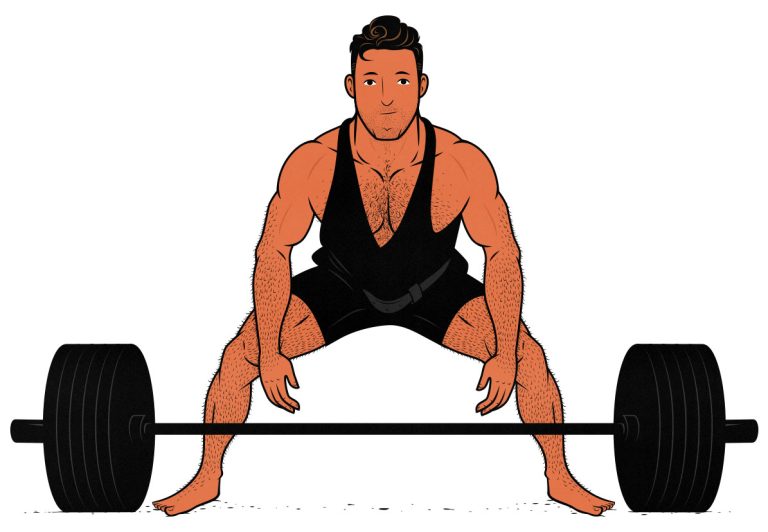
When you pick up the bar, your spinal erectors and lats will be firing as hard as they can to help keep your spine in a neutral position. That will reduce the sheer stress on your spine, which is great, while still putting a ton of pressure on it, making all of the bones and connective tissues in your body much denser and tougher.
So, first of all, there are the obvious back muscles that will be strengthened, including your lats, which fan over most of your upper back:
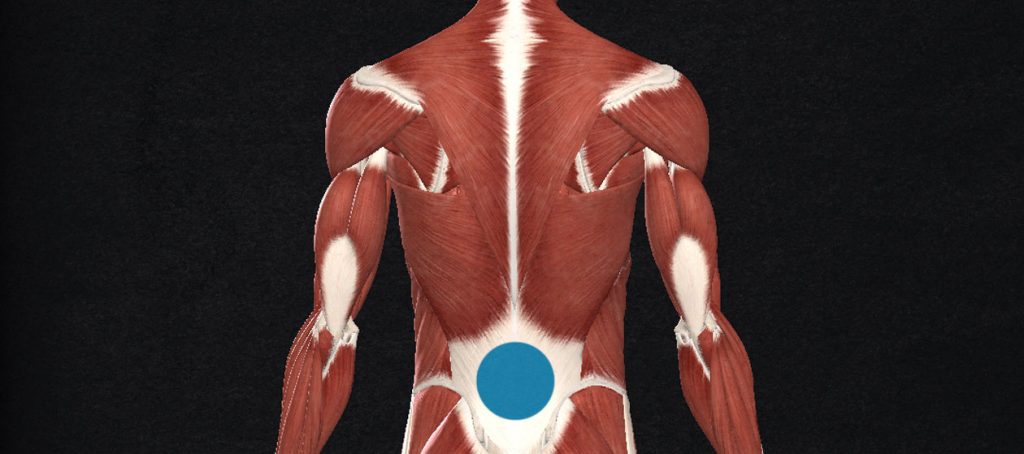
What’s so cool about the deadlift, though, is how many layers of spinal erectors it will strengthen, and how much growth potential they have:
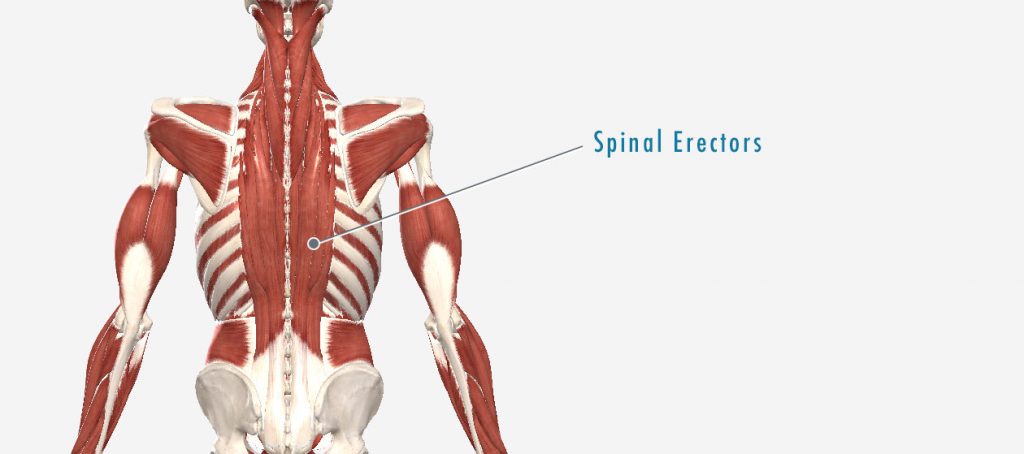
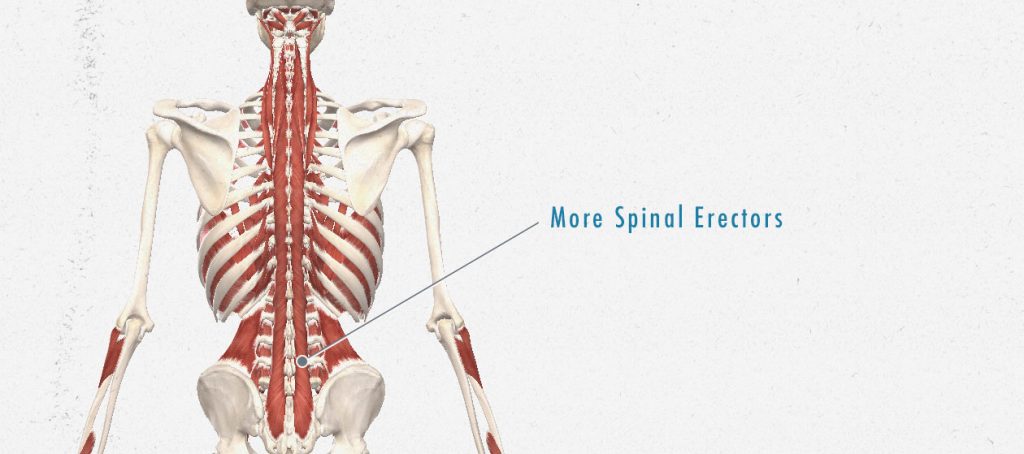
These spinal erector muscles are absolutely essential for your posture, and they’ll make your back much thicker when viewed from the side. This might not be a big deal for guys with a naturally stockier body type, but most ectomorphs have fairly skinny torsos by default. Bulking up our spinal erectors, then, is a great way to banish a bony back.
The deadlift will also strengthen your glutes and hamstrings, which is interesting because the glutes will help to hold your hips in the correct position. Having strong glutes will ease the load on your upper back and help improve your upper-back posture.
The deadlift is hands down the best trap exercise. Your traps are the diamond-shaped muscle running alongside your neck down your spine. Your traps are arguably the most masculine and impressive of all the muscles in your body. You’ll look strong if you have strong traps sitting atop your shoulders. Or, as some guys like to say, yoked.
Finally, the deadlift also engages your lats to help hold your back in position, which will help to make your upper back wider. (The chin-up is a much better lat exercise, but the deadlift still helps.)
The problem with the deadlift is that it requires quite a bit of upper-back strength to do it safely. If you’re a skinny beginner eager to bulk up his back, the deadlift might not be the best way to ease into it. Better to start with a slightly easier variation, such as the Romanian deadlift.
With the Romanian deadlift, you start in the top position and only go as low as your mobility allows. Because you aren’t sinking as low, your torso remains more upright, requiring less upper-back strength to do properly. When that starts to feel comfortable, try raised deadlifts. When that’s going well, try deadlifting from the floor.
The Front Squat (or Goblet Squat)
The front squat is a sorely underrated upper-back exercise. That’s because most guys squat like powerlifters, favouring the barbell back squat (often with a “low-bar” position). Strength training routines aren’t ideal for bulking up, though. Guys trying to bulk up should probably favour front-load squats, such as front squats and goblet squats.
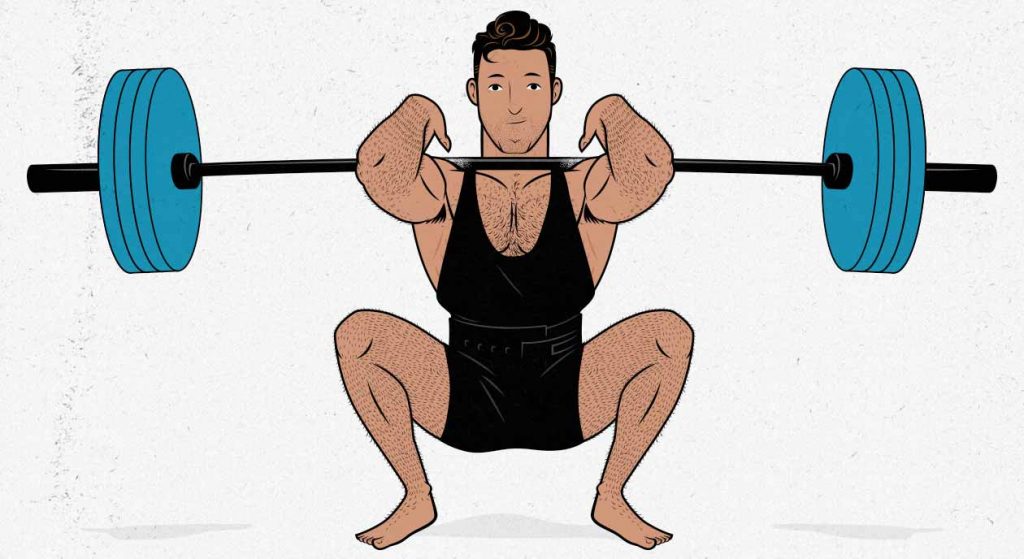
When you hold the weight in front of your torso like that, it makes your body want to collapse forward. If you think about it, you’ll realize that this “collapsed forward” position is the postural issue most skinny guys struggle with. The front squat directly strengthens the muscles that hold our backs upright.
As you can imagine, having to support a ton of weight in front of our torso puts a huge load on our upper back muscles, and therein lies the power of the front squat for bulking up our upper backs whilst improving our posture.
The front squat isn’t just great for building a bigger upper back, either. It also allows us to squat with a more upright torso and use a large range of motion without our femurs jamming up against our hips. This puts our quads through a larger range of motion, which is great for our lower bodies.
Finally, the front squat is brutal on our abs and obliques. It helps us learn to lift while keeping our ribs down and abs firing. This is also incredible for improving our upper-back posture.
The problem with the front squat is that it’s an absolute beast of an exercise, and I don’t mean that in the pleasant way. Holding a barbell on the fronts of your shoulders like that with your wrists bent to China is even more difficult than squatting a wild boar. You already need to have fairly good posture and mobility. If you’re struggling with upper-back strength and posture, you might be unable to front squat properly.
If you’re a beginner with poor posture, try goblet squats. The goblet squat is where you hold a dumbbell in front of you while squatting. You don’t need great mobility or posture to do it well, and as you get stronger at it, you’ll find that your upper back strength and posture improved, eventually allowing you to transition to a front squat.
There’s no real downside to the goblet squat as a beginner. The only problem is that you’ll eventually grow too strong for it. At that point, when you can squat the heaviest dumbbell for 10–15 reps, you’ll need to progress to the barbell front squat. By then, you should be ready for it.
The Chin-Up (or Lowered Chin-Up)
Most guys know the chin-up is an incredible lift for building up your upper back. While the deadlift and front squat focus more on your spinal erectors and postural muscles, the chin-up focuses more on your lats and rear delts, some of the larger muscles in your upper back.
The chin-up is also great for improving your upper back posture because it stimulates your abs, which we’ll cover in a second.
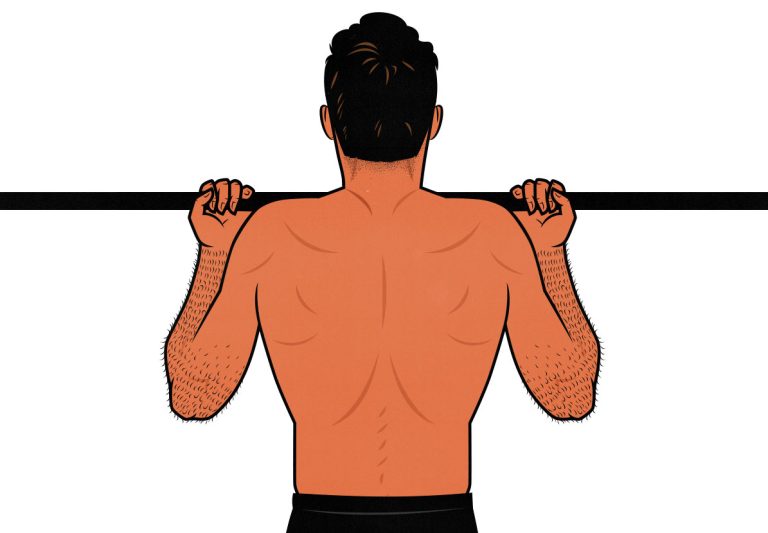
The trick with chin-ups is to do them with an underhand grip. That will allow you to use a much greater range of motion, which will bring a greater number of overall muscle fibres into the lift (including your biceps). That’s going to help you build a more balanced upper back, and it’s going to help you build a more aesthetic physique.
Since the idea is to lift with a larger range of motion and to bring as much overall muscle mass into the lift as possible, you also want to start the chin-up from a dead hang, then pull your chest to the bar.
What’s especially interesting about chin-ups is that they aren’t just good for our upper backs and biceps; they’re also great for our abs. Bret Contreras, PhD, did EMG research to determine which exercise was the best for the abs, and the chin-up won.
Chin-ups are good for your abs because you need to keep your ribs down while pulling up your body with your back muscles. As we’ll discuss in the posture section, learning how to keep your ribs down by engaging your abs is incredibly for improving your upper back posture.
The problem with chin-ups, especially if you’re doing them with a huge range of motion, is that they’re damn hard. The advantage us skinny guys have is that our bodies are lighter, but still, doing chin-ups with lanky arms and a bony back is pretty tough.
The solution for skinny beginners is to step (or jump) up into the top position and lower yourself slowly back down. The lowering portion of the lift will work your back muscles, making them bigger and stronger. Over time, you’ll develop the strength to pull yourself back up.
The Barbell & Dumbbell Row
We usually consider the row an accessory exercise for the deadlift or chin-up. If you row while bending over at the waist with an unsupported chest, such as with a barbell row, then it’s going to be hardest on your spinal erectors. On the other hand, if you row with a supported chest, such as with a one-armed dumbbell row, it will be hardest on your lats.
The row is less essential than the deadlift and chin-up for building a bigger, stronger, straighter upper back. It’s still incredibly useful, though. Do it later in your workouts, after your heavy deadlifts and chin-ups.
Will a Strong Back Fix Your Posture?
Indeed, poor posture is usually caused by your postural muscles being too weak. So simply becoming bigger and stronger can help. However, unfortunately, it’s not quite that simple.
To improve your upper-back posture, we also need to strengthen your core. After all, skinny guys often have skinny abs as well. That’s why we often don’t have visible abs, even at low body-fat percentages. Some skinny guys think they’re skinny-fat because of bad posture and small abs.
Improving Your Overall Posture
There is something about a big, strong, and straight upper back that makes someone look powerful. It makes me think of a person who can accomplish whatever they want.
Take, for example, the venerated George Washington, who was known for his formidable posture. To quote social psychologist Amy Cuddy from her moving Ted Talk, “Our bodies change our minds, our minds change our behaviour, our behaviour changes our outcomes.”
If you’re curious about how our posture and body language can have such a deep impact on us, here’s a TED Talk by Amy Cuddy called Your Body Language Shapes Who You Are.
Having a strong, mobile upper back is a worthy practice for anyone trying to feel and be perceived as attractive as well as build muscle. While some have maintained their youthful posture since birth, others have lost it due to a variety of different issues.
Your activity level, stress and occupation are all powerful contributors to your posture. While there are many ways to improve posture, this post will specifically look at how improving rib movement can help bolster your upper back.
How Breathing Impacts Posture
Read this if you haven’t watched the video: When you breathe, your ribs are designed to move based on what cycle of the breath you are in. When you inhale, the ribs are elevated and expanded by certain muscles; when you exhale, your muscles are squeezed down like an accordion. This exhalation portion is of utmost importance as it allows your main respiratory muscle, the diaphragm, to reach a dome position, which then allows you to effectively inhale. A full exhalation is also the best way to activate a key spinal stabilizer: the transverse abdominus.
The movement of your ribs directly impacts the structures of the shoulders, the head, and the neck. Regardless of whether your back is straight or slightly rounded, it’s possible that your ribs are stuck in a position of inhalation. This overdevelops the muscles that open the ribs, leaving the muscles that close the ribs weaker and underdeveloped.
When the inhaler muscles become overdeveloped, it pulls the rib cage open and forward, stretching your diaphragm into a flattened state. This takes your diaphragm out of the proper inhalation position. Without the diaphragm, your body will turn to secondary respiratory muscles like the neck and back.
Diaphragm breathing is ideal because it uses pressure to suck air in and fill up the ribs evenly. Neck and back breathing can be a problem because it yanks on the ribs and diverts air mostly to the lower ribs. This means that relying on your neck and back muscles to help you inhale can significantly tighten your upper back. After all, there is much less air expanding there.
Air pressure in the upper back is also important for overall upper-body strength. With this stiffness of our ribcage, we lose the ability to move our ribs effectively. This hampers our ability to bend and twist our core, meaning we need to get that flexibility from our lower back and neck instead. This can make it more likely to get injured, it can make lifting much less comfortable, and it also doesn’t look very good.
This information has influenced my approach to improving the appearance and function of someone’s upper back. In the past, I would cue people to straighten their back when doing rows and lat pulldowns (or at-home alternatives). Now I prioritize rib position and movement.
Someone with flared ribs can be more likely to row in an imbalanced fashion, relying heavily on back extension and head protrusion. Below is a video detailing three exercises:
- The first to move the pelvis in a position that allows better diaphragm function
- The next to shunt air into your upper back
- And the final one is a rowing exercise for the upper back muscles where you can apply these two postural exercises.
For someone having a hard time with their upper back posture, I recommend running through these three postural drills once a day with the at-home version.
The Best Exercises for Improving Posture
Here’s a simple routine that I use to help my clients improve their upper-back posture. The goal of these postural exercises is to increase how far you can pull your shoulders back without neck and lower back tension whilst completing full breath cycles.
Until you’re proficient at exhaling fully and inhaling properly, keep doing the 90/90 hip lift and All-4 Reach. Each exercise done consistently over time will improve your posture and ability to create pressure without having to think about it, making lifting more natural and fun.
This is best performed as a daily routine. As Dan John says, “If it’s important, do it every day.”
The 90/90 Hip Lift
The 90/90 hip lift is a great exercises for teaching you how to keep your ribs down and your abs engaged while breathing. If you can master that skill, it’s going to let you do all of your lifting with improved posture, which will allow you to strengthen your postural muscles with every single compound lift that you do.
For example, if you can keep your ribs down and your abs engaged while doing front squats, then the front squat becomes not only a great exercise for bulking up your legs, glutes, and upper back but also a great exercise for strengthening your abs and obliques.
I’m going to show you how to the 90/90 hip lift using a balloon, which is going to make it even easier to engage your abs. The balloon is optional, but I recommend trying it at least once.
All-4 Reach Exercise
Now that you know how to keep your ribs down by engaging your abs, we’re going to use the all-4 reach exercise to practice moving our limbs while keeping good posture. After all, this is what we do while lifting weights, going through the full range of motion while keeping our abs engaged.
Breathing Pit Pulls & Elbow Drive
This this rowing exercise, we’re going to practice lifting weights while maintaining good upper-back posture. This will strengthen our upper back muscles in the correct position. Once these upper-back muscles get big and strong enough, we’ll be able to naturally hold ourselves with better posture without even needing to think about it.
Over time, these exercises should get easier and more intuitive. At a certain point, you won’t need them anymore. You’ll intuitively lift with proper posture. Great.
Once you’re happy with your back posture while lifting weights, you can skip these drills and just keep doing more traditional back strengthening exercises, such as rows, chin-ups, front squats, and deadlifts.
Still, when you do your normal upper-back training, be mindful of how often you use your neck and lower back. While they can help you lift more weight, it’s good to diversify your movement to improve adaptability and decrease the occurrence of overuse.
My Posture: Before and After
As an experiment, I took before photos, did the routine for ten days, and then took after photos. Both sets are taken in a relaxed setting: no flexing or trying to have perfect posture.
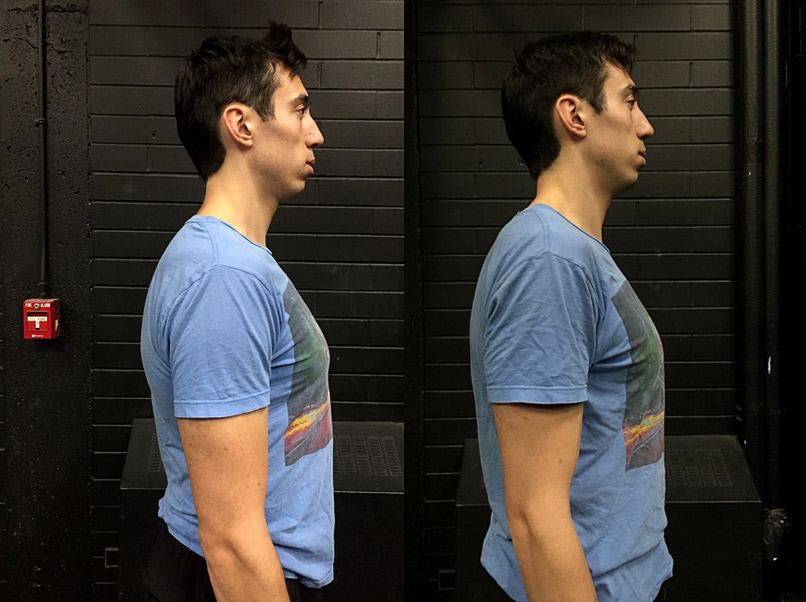
What stands out to me is how far my shoulder and arms have moved back in just ten days. According to Amy Cuddy’s research, if you can make your natural standing posture more open, this will not only place less stress on your joints but also help you feel stronger and more confident.
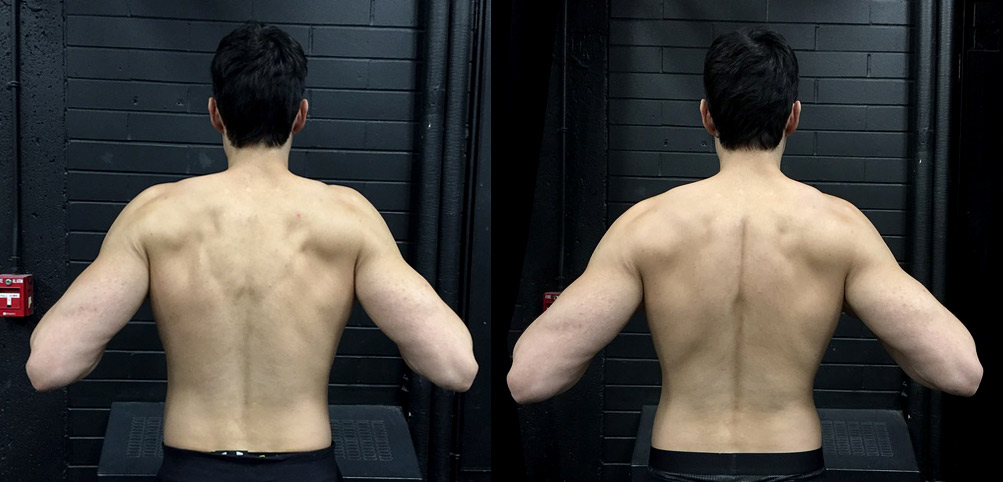
What stands out to me is how much tension there is around my neck in the before photo and how much lower my shoulders are in the second photo. This means I can separate my shoulders from my neck when doing rowing exercises. This allows for a cleaner, more athletic rowing pattern that will build muscle in a more balanced and attractive way. It’s also a big improvement in day-to-day performance. For example, being able to turn your head around independently of your body is useful when checking blind spots while driving.
The ability to move each part of your body independently is a hallmark of great athletes from every discipline, and from an aesthetic standpoint, it looks much more relaxed and confident.
Now, far more impressively, here’s what it looks like if you combine it with it a bulking routine and gain a bunch of muscle while improving your posture:
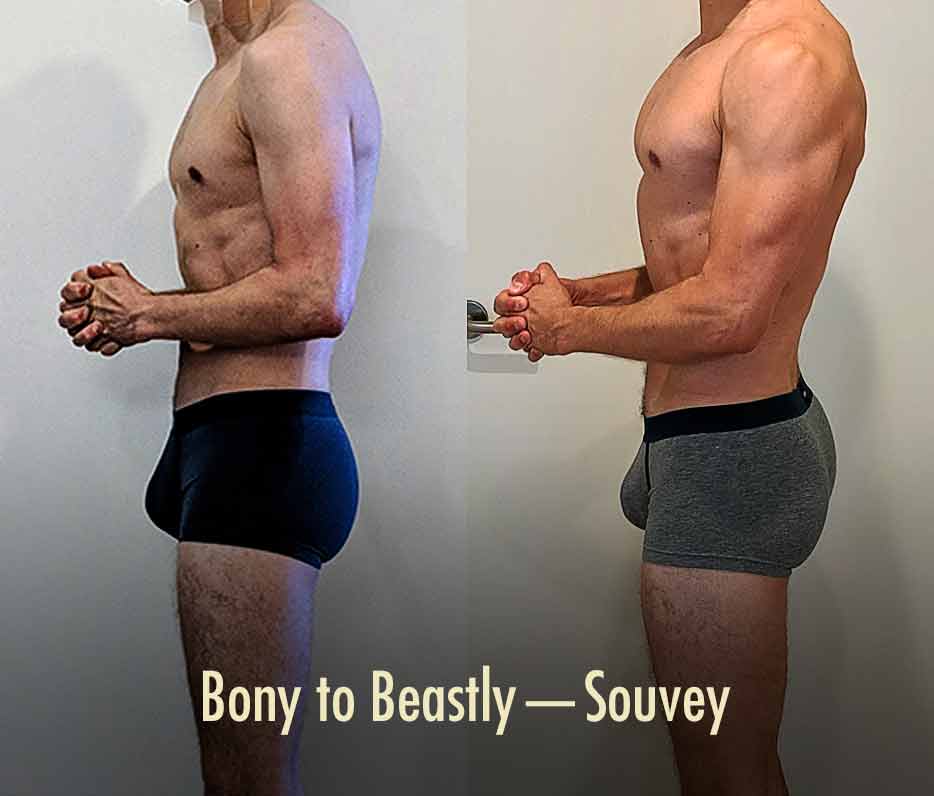
At-Home Posture Routine
Now, you might not always want to be doing your posture exercises at the gym. That’s no problem. You can do them just as easily at home. They don’t require any equipment.
Here’s the simple routine I used to improve my posture at home. Do it once per day, every day, and you should see steady improvements.
- 90/90 Hip Lift with Balloon – 1 x 6 breaths
- All 4 Reach – 1 x 6 breaths
Change does not roll in on the wheels of inevitability, but comes through continuous struggle. And so we must straighten our backs and work for our freedom. A man can’t ride you unless your back is bent.
– Martin Luther King Jr.
Summary
To improve your posture, follow a bulking routine built around the big compound exercises. The compound exercises that are the best for fixing your posture are:
- The deadlift: to strengthen your spinal erectors, traps, lats, and hips.
- The front squat: to strengthen your spinal erectors, the postural muscles in your upper back, your abs, and your obliques.
- The push-up: to strengthen your abs in a plank position.
- The chin-up: to bulk up your lats, traps, and rear delts, adding a ton of mass to your upper back. The chin-up is also a great exercise for your abs, which will help you keep your ribs down.
Then, to help improve your lifting technique and posture, do a quick drill every day to help you keep your ribs down. Then, with your abs engaged, practice moving your arms and legs around. Once you master that skill, you can fix your posture by gaining upper-back size and strength on the big compound lifts.
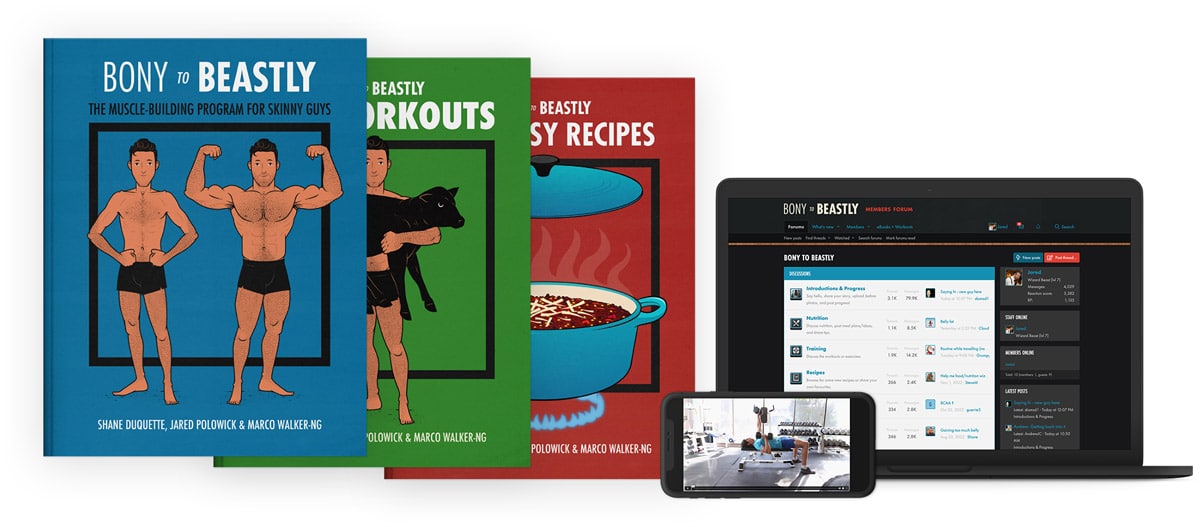
Alright, that’s it for now. If you want more muscle-building information, we have a free bulking newsletter for skinny guys. If you want our foundational bulking program, including a 5-month full-body workout routine, diet guide, recipe book, and online coaching, check out our Bony to Beastly Bulking Program. Or, if you want a customizable intermediate bulking program, check out our Outlift Program.
Marco Walker-Ng is the founder and strength coach of Outlift, Bony to Beastly, and Bony to Bombshell. He's a certified trainer (PTS) and nutrition coach (PN) with a Bachelor's degree in Health Sciences (BHSc) from the University of Ottawa. He has over 15 years of experience helping people gain muscle and strength, with clients including college, professional, and Olympic athletes.

